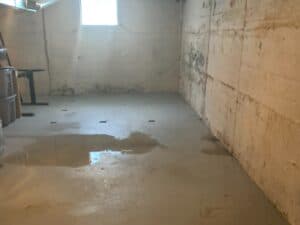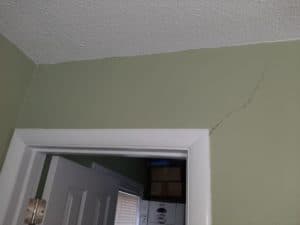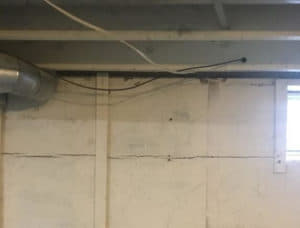
Historically, people have built their homes out of whatever material was available. Foundations were originally constructed of wood, stone, or brick. In the last century, this has gradually changed to concrete foundations. Cinder blocks and poured concrete foundations are roughly the same in terms of strength and durability.
However, they can show stress and damage in different ways. If you're searching for foundation repair near you, it's crucial to find experts who understand the unique challenges of concrete foundations. Acculevel is a family-owned and operated company specializing in foundation repair and waterproofing. Since opening our doors in 1996, we’ve helped more than 35,000 homeowners restore the health and strength of their homes using repair methods specifically designed for concrete foundations.
In this article, we’re going to discuss potential signs of foundation damage in a poured concrete foundation, how serious those problems are, and the best way to repair them. We’ll also provide you with additional resources exploring the repair options, as well as some preventative measures you can take.
Unlike a classic mystery novel, we’re going to start by revealing the culprit. If you have cracks forming in your foundation walls, it’s probably because of water in the soil.
In our industry, we call this hydrostatic pressure. It’s the result of too much water in the ground; once the soil is completely saturated, the excess water collects around objects in its way. This object is sometimes your home’s foundation.
And since concrete is a porous material, water is able to seep into it. This can sometimes show up as water intrusion- if you’ve ever had a puddle in your basement but no cracks in the walls? That’s how that can happen.
That doesn’t mean the water seeping into your foundation won’t create cracks- given enough time, that water intrusion will eat away at the concrete until it does crack. But it’s possible for you to have one before the other.

This photo was taken by an Acculevel project advisor during a free in-home assessment. Water has been seeping in through the cove joint (where the wall and floor meet).
Hydrostatic pressure leads to more than just tiny cracks in the foundation and puddles in the basement. Over time- and depending on the weather and season- those cracks will widen. Eventually, they will expand until they compromise the stability of your home.
Basement flooding leads to biological growth, compromised air quality, and damage to your basement and anything you store in it.
A high quality water drainage system will address the hydrostatic pressure by giving that water a designated (and controlled!) way to get into your basement. It then moves the water to your sump pump, which expels the water out of your home through a discharge line. This gives you a clean and dry basement while also reducing the pressure against your foundation. This reduced stress makes it less likely your poured concrete foundation will crack under the strain.
If you need to know more about basement waterproofing, download our homeowner’s guide. This is a resource available to all homeowners for free, and it tackles all of the frequently asked questions that we hear from our customers.
Does your home have a crawl space with water intrusion issues? You can learn more about how water damages your home in this article.
There is more than one way to repair a foundation crack, and Acculevel has tried most of them. (We limit our experimentation to professional methods- no DIY recipes here!)
Our research has made it clear to us that the epoxy fill method is the most consistent, reliable, and longest lasting repair option. We warranty our detailed crack repair will last for 5 years. The epoxy can be painted over if you aren’t finishing your basement but want a more attractive look.

This photo was taken by an Acculevel crew member, after completing interior crack repair.
This particular crack was discovered because water was seeping through it. When the drywall and carpeting became wet, the homeowner removed the drywall and furnishings to expose the damaged area.
In many instances, the foundation crack is only visible from the inside of the home. If this is the case, interior epoxy repair is all that is required. However, there are times when the crack goes all the way through the poured concrete wall. If this is the case in your foundation, you will also need some exterior crack repair.
Exterior crack repair may require some excavation, depending on the location of the crack and the underground depth of your basement. Once the crack is exposed, it should be filled and covered with an adhesive layer of mastic and encapsulation liner. These liners repel water and keep the crack protected against damp soil, once the excavation is filled back in.
You can learn more about epoxy fill crack repair in this article, which takes you through the process step-by-step. You can also learn more about the types of cracks that form in a foundation and when you should be worried.
Sometimes, water causes foundation problems that you see in places besides the foundation. Hydrostatic pressure is more likely to happen in clay-based soils (sometimes called expansive soil). In more granular soil, excess water is more likely to cause erosion around the foundation.
All foundations settle naturally, as the weight of the home exerts pressure on the soil below. But erosion can accelerate this settling in one area or corner, so that it doesn’t happen evenly.
Uneven settling causes stress throughout the house. The materials used for home constructions- wood, metal, and concrete- are not pliable. When one section of the foundation is sinking faster, it pulls at the other sections, but they can’t stretch like elastic.
Settling cracks form at the stress points, and not just in the foundation. You will also see cracks in your home’s drywall, especially around doors or windows. Those entry points may also begin to stick or jam- windows that won’t stay open without a prop, or doors that won’t stay shut unless they’re locked.

This photo was taken by an Acculevel project advisor during a free in-home assessment. The door in this photo is hard to close; the framework has shifted and the drywall has cracked.
If your foundation is settling unevenly, you need piers installed to stabilize it and stop it from settling any deeper. In some cases, piers may even be able to lift the settled section back up, closer to its original position (level with the rest of the house). But lift isn’t guaranteed, and it’s not the primary goal; piers are designed to hold the foundation in place. If you're looking for professional foundation repair in Evanston and surrounding areas, installing piers can be a crucial step to ensure your home remains stable and secure.
There are two kinds of steel piers typically used for foundation repair. Acculevel recommends helical piers for residential use. This is because push piers use the weight of the building as leverage, and that can increase the strain on an already-struggling foundation.
Helical piers are more like giant screws driven into the earth around the house. When they reach the necessary depth and stability (measured by pressure gauge), they are then secured to the foundation to hold it still. Excavation is necessary, and it is critically important that piers are installed by an experienced and qualified company to do foundation repair near you.

This is an illustration of helical piers attached to a home.
You can learn more about both types of piers and how they compare in this article. We review the average costs of settling foundation repairs for you. And if you’ve seen these signs, but they seem centered around a porch, chimney, or similarly adjacent area? Helical piers can be used to stabilize these structures, too!
Earlier, we explained how epoxy crack fill is a good repair method for minor cracks in your foundation.
But if you have a long horizontal crack forming across your foundation? You need more than just crack repair, because that crack is a warning sign. It’s telling you that your wall is under so much (hydrostatic) pressure that it’s starting to move.
Right now, it’s just a crack. But if you don’t get that wall stabilized and secured, it’s going to keep moving until it splits and starts to bow inward.

This photo was taken by an Acculevel project advisor during a free in-home assessment.
If the wall is only badly cracked, or bowing less than 3 inches inward, the best solution is going to be carbon fiber straps.
These straps are the least expensive way to stabilize a bowing wall, as well as the least intrusive. Carbon fiber straps can be installed entirely from the inside of your basement, with minimal disruption to your home and routine.

These photos were taken by an Acculevel team member, after installing carbon fiber straps. You can see the straps are secured to the top and bottom of the basement wall. (You can also paint over the straps once they are fully dried.)
Sometimes basement walls bow more than 3 inches, especially if the foundation has been neglected for a long period of time. These walls can still be repaired, they just need a more substantial (and expensive) repair process.
The alternatives are either wall anchors or helical tiebacks. Either of these methods will work, but wall anchors require excavation, while tiebacks are more expensive.
We have detailed articles about each of these bowing wall repair methods:
You should find a quality contractor in your area who specializes in foundation repair. This is one area where we don’t recommend a general contractor or handyman. (And we certainly don’t want you to experiment with DIY methods!) Your foundation is a critical part of your home- everything rests on it, quite literally.
If you’re not sure how to find a good foundation repair company, check with friends, neighbors, or your realtor for recommendations. Use our checklist of questions to ask a contractor, to help you screen potential options; you want to find the best fit for you and your family. Also, make sure they are properly insured and accredited by the Better Business Bureau.
Do you live in Indiana, or in any of the states around the Hoosier state? If so, contact Acculevel for a free in-home consultation. We’ll schedule an appointment for you with one of our experts. They will come to your home, discuss your concerns, the history of your home, and what your future plans for your basement might be.
Once they have a clear understanding of your experiences, they’ll do a thorough evaluation of the entire home. Our goal is to provide a whole-home solution; we want to treat the symptoms as well as the cause of the problem. You and your project advisor will review your options, discuss the recommended options, and formulate a plan together.
[DISPLAY_ULTIMATE_SOCIAL_ICONS]